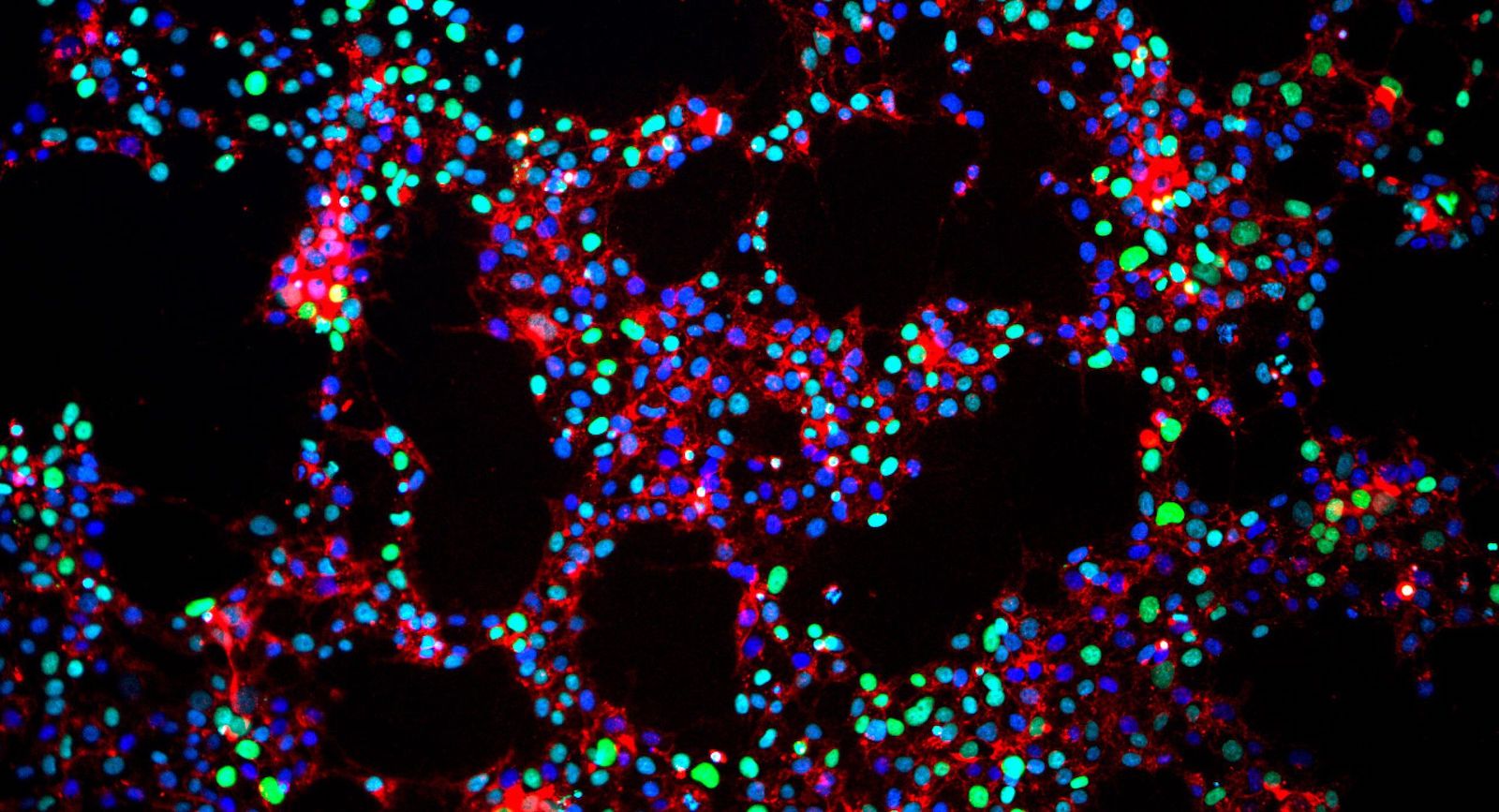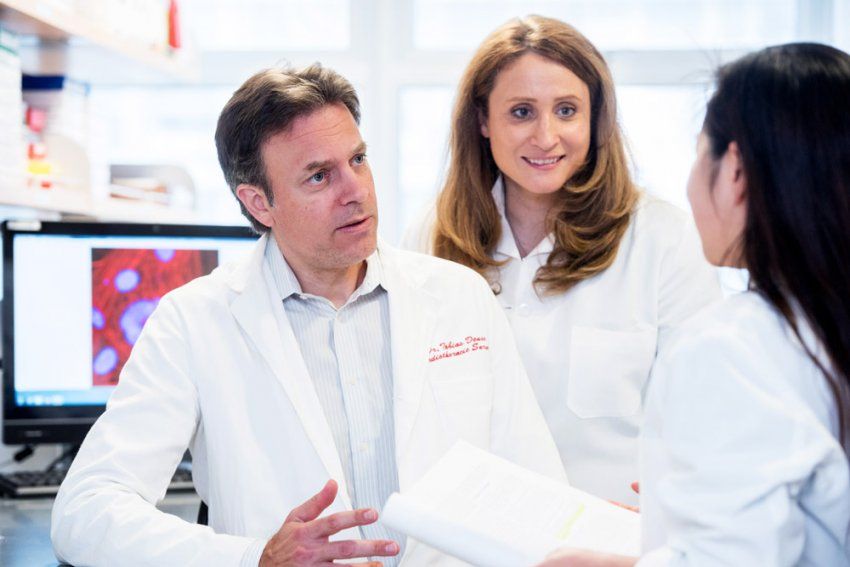Tobias Deuse, MD and Sonja Schrepfer, MD, PhD Lead Research Team Unearthing New Clues to Stem Cell Transplant Rejection

Mutations in Mitochondrial DNA Induced by Cell Reprogramming May Trigger Immune Response
Because the same patient would be both the donor and the recipient of cells derived from these so-called induced pluripotent stem cells (iPSCs), these cells would be seen as “self” by the immune system, the thinking went, and not subject to the problems of rejection that plague conventional transplants.
But iPSCs haven’t emerged as the cure-all that was originally envisioned, due to unforeseen setbacks, including the surprising preclinical finding that iPSC-derived cell transplants are often rejected, even after being reintroduced into the organism the cells were sourced from.
Scientists have struggled to understand why this rejection occurs. But a new study from the UC San Francisco Transplant and Stem Cell Immunobiology (TSI) Lab, in collaboration with the Laboratory of Transplantation Genomics at the National Heart, Lung, and Blood Institute (NHLBI) and Stanford University, shows that the adult-to-iPSC conversion process can mutate DNA found in tiny cellular structures called mitochondria. These mutations can then trigger an immune response that causes mice and humans to reject iPSCs, and stem cell transplants more generally.
“The role of mitochondria has been largely ignored in the field of regenerative medicine, but earlier efforts in our lab suggested that they may affect the outcome of stem cell transplants, said Tobias Deuse, MD, the Julien I.E. Hoffman Chair in Cardiac Surgery at UCSF and lead author of the new study, published Aug. 19 in Nature Biotechnology. “It’s important that we understand their role so that we’re able to reliably quality-control our engineered cells and make sure stem cell products can be transplanted into patients without rejection.”

The “nuclear” human genome, so called because it resides in the cell’s nucleus, contains more than 20,000 protein-coding genes and 3 billion DNA bases – the four-letter chemical alphabet that constitutes the genetic code. The human mitochondrial genome, by contrast, contains only 13 protein-coding genes and fewer than 17,000 bases. However, in tissues with high energy demands, the tiny mitochondrial genome can contribute disproportionately to cells’ total protein content.
“In cells that do a lot of work, like heart muscle cells, up to a third of the cell’s protein-producing mRNA molecules are mitochondrial in origin. This means that the burden of a single mitochondrial mutation may be tremendous. You don’t end up with just a few proteins that can potentially provoke an immune response – you end up with thousands,” said Sonja Schrepfer, MD, PhD, professor of surgery and senior author of the new study.
To show that such mitochondrial mutations can trigger an immune response, the scientists created hybrid stem cells with nuclear DNA from one mouse strain and mitochondrial DNA from another. They transplanted these cells into mice with identical nuclear DNA, but whose mitochondrial DNA differed by a single base in two protein-coding genes. A few days post-transplant, they harvested immune cells from the mice and exposed the cells to various mitochondrial protein fragments. The only proteins that triggered a response were those produced by the two “foreign” mitochondrial genes.
Multiple clinical trials have started w/ induced pluripotent stem cells (iPSCs). But they failed to recognize that there could be new mitochondrial mutations inducing an immune responsehttps://t.co/oqimtrE8ex@NatureBiotech by @UCSF Tobias Deuse, Sonja Schrepfer
+ collaborators pic.twitter.com/rY6wC855Ds— Eric Topol (@EricTopol) Eric Topol, August 19, 2019
Though similar experiments can’t be performed in humans, the scientists were able to devise a clever workaround. “We recruited liver and kidney transplant patients and designed experiments that took advantage of naturally occurring sequence differences in the mitochondrial DNA of donors and recipients,” Deuse said.
As in the mouse experiments, the researchers isolated immune cells from each transplant recipient – three and six months later in this case – and exposed the cells to mitochondrial protein fragments. The results were identical: the recipient’s immune cells were only triggered by the “foreign” mitochondrial proteins that originated from the organ donor.
“In both mouse and human, even one mitochondrial mutation is enough to have a recognizable immune response,” Schrepfer said.
But an important question remained: would iPSC-derived cells behave the same way as the liver and kidney cells?
It turns out that the iPSC conversion process is highly mutagenic, and gives rise to many new, immune-activating mitochondrial mutations, said Deuse. “Under normal physiological conditions, mitochondrial DNA is 10 to 20 times more susceptible to mutation than nuclear DNA. Transforming adult cells into stem cells is a harsh process, so we expected mutation rates to be just as high or higher.”
Understanding why stem cell transplants are rejected is vital for regenerative medicine. #NIH/@UCSF study finds converting adult cells to iPSCs can mutate DNA in mitochondria. This can trigger an immune response causing rejection in organ transplants. https://t.co/scPS5Jm8L0
— Francis S. Collins (@NIHDirector) Francis S. Collins, August 19, 2019
Moreover, unlike the nucleus, mitochondria lack the molecular machinery that repairs DNA. Instead, the body relies on the immune system to find and destroy cells that produce unfamiliar mitochondrial proteins – a clear sign that the mitochondrial DNA has mutated.
But cells that become iPSCs are reprogrammed and grown outside of the body, and do not undergo this weeding out process by the immune system, Shrepfer said. “We don’t make iPSCs in an organism, we make them in a petri dish in the absence of immune surveillance. The longer we culture these cells, the greater the chance that new mutations will be introduced, or that very rare mutations that are already present will be amplified. This makes iPSCs more likely to be rejected when transplanted.”
Study co-author Hannah Valantine, MD, whose lab performed the genetic sequencing to identify these mitochondrial DNA mutations, said that the findings could have a significant impact on the field of transplantation.
“This study uncovers a possible new mechanism by which transplants are rejected, and which might be leveraged in the future to develop better diagnostic and immunosuppressive agents,” said Valantine, lead investigator of the Laboratory of Organ Transplant Genomics in the Cardiovascular Branch at NHLBI, part of the National Institutes of Health.
But iPSC transplants aren’t doomed, say Deuse and Schrepfer, who previously discovered a way to make iPSCs “invisible” to the immune system – a technique that could ensure that iPSCs and other stem cells with mitochondrial mutations aren’t rejected. But without this sort of invisibility cloak, the new study suggests that clinicians may need to perform careful screenings for mitochondrial mutations before administering stem cell therapies.
“The bottom line is that we want to make people aware of this phenomenon. Just because iPSCs are derived from your own cells doesn’t necessarily mean they won’t induce an immune response,” Schrepfer said. “It’s very easy to introduce mutations during iPSC production, so it’s critical that iPSC and stem cell products used therapeutically are screened for mitochondrial mutations prior to transplant.”
Authors: Additional authors include Xiaomeng Hu and Dong Wang of UCSF, the University Heart Center Hamburg, the Cardiovascular Research Center Hamburg, and the German Center for Cardiovascular Research; Sean Agbor-Enoh of The Johns Hopkins School of Medicine and NHLBI; Martina Koch, Malik Alawi, Bjoern Nashan and Rainer Kiefmann of the University Medical Center Hamburg-Eppendorf; Matthew H. Spitzer of UCSF, the Parker Institute for Cancer Immunotherapy, and the Chan Zuckerberg Biohub; Alessia Gravina and Raja Rajalingam of UCSF; Argit Marishta and Yanqin Yang of NHLBI; Bjoern Peters and Zeynep Kosaloglu-Yalcin of the La Jolla Institute for Allergy and Immunology; Hermann Reichenspurner of the University Heart Center Hamburg, the Cardiovascular Research Center Hamburg, and the German Center for Cardiovascular Research; and Irving L. Weissman of the Stanford Institute for Stem Cell Biology and Regenerative Medicine, and the Ludwig Center for Cancer Stem Cell Research and Medicine at Stanford.
Funding: The study was supported by research grants from the Deutsche Forschungsgemeinschaft (DFG; SCHR992/3-1, SCHR992/4-1), the Fondation Leducq (CDA 2013-2015), the Max-Kade-Foundation (DFG), and the NIH (NIH 1S10OD018040-01).
Disclosures: The authors have no competing interest.
The University of California, San Francisco (UCSF) is exclusively focused on the health sciences and is dedicated to promoting health worldwide through advanced biomedical research, graduate-level education in the life sciences and health professions, and excellence in patient care. UCSF Health, which serves as UCSF’s primary academic medical center, includes top-ranked specialty hospitals and other clinical programs, and has affiliations throughout the Bay Area.
This article originally appeared at UCSF News on August 19, 2018 is reprinted here with permission. Several Tweets have been embedded in the text which were not in the orginial TSI article.
